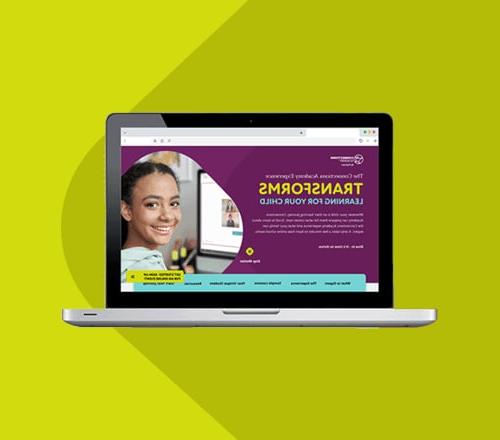How to Help Students with Dysgraphia
byConnections Academy
4 min to read
Dysgraphia is a condition that can affect a person’s ability to correctly write letters or express themselves in writing. Though not officially a learning disability under IDEA (Individuals with Disabilities Education Act), dysgraphia can make school and work quite difficult for students.
While dysgraphia poses some challenges, there are many ways to help students (and adults). With the proper support from parents, teachers, and Learning Coaches, kids with dysgraphia can thrive in school and beyond.
What Is Dysgraphia?
Considered a learning difference similar to dyslexia, dysgraphia is a neurological disorder that typically leads to people having trouble with transcription, the set of skills including typing, handwriting, and spelling, regardless of their cognitive abilities, age, or adequate instruction.
Signs of Dysgraphia
There are quite a few signs of dysgraphia, but most learners will not present all of them. Some characteristics show up at different ages and frequently overlap with other conditions. Dyslexia, for example, shares many commonalities with dysgraphia, and though they are distinct neurological disorders, they can occur together.
The important thing for parents, teachers, and Learning Coaches to do is pay close attention to the signs and decide if further intervention is necessary.
Though dysgraphia can be difficult to diagnose, some signs include the inability to hold a pen or pencil
Difficulty writing complete words or grammatically correct sentences
Inability to draw a straight line
Struggles to form letters or use correct spacing
What Impact Does Dysgraphia Have on Students’ Lives?
Because writing is a large part of everyday life in school—organizing their thoughts for essays, answering test questions, or even taking notes—dysgraphia can have a large impact if not identified and supported properly.
Students with dysgraphia often can find writing frustrating, especially if they are unidentified. They may feel embarrassed about needing more time to write than their peers or embarrassed by their handwriting or spelling. Their teachers, who could be unfamiliar with dysgraphia, may come to the wrong conclusion about the student’s ability to understand the material if there are some written assignments in the course. These problems can lead to emotional stress for the student.
How to Diagnose Dysgraphia
After seeing signs of dysgraphia, a teacher or family member might suggest a meeting to discuss options for supporting the student. Sometimes this may include an evaluation. The team will determine the next steps to help the student.
What Tests Are Used to Identify Dysgraphia?
Usually, the student will take a formalized handwriting assessment, which measures the legibility and speed of the student’s handwriting. The student may also undergo a test that shows the level of integration between motor and visual skills.
A full assessment is critical, as dysgraphia is often concurrent with ADHD as well as other learning differences. As with most learning differences, it’s best to diagnose dysgraphia as early as possible. If a student gains the tools to cope with their learning difference early, they are more likely to stay on track with their fellow students.
How to Help Students with Dysgraphia
If a student receives an IEP or a Section 504 Plan, there are many in-class accommodations for dysgraphia that can greatly help students.
Use speech-to-text tools: By speaking instead of physically writing, students can better focus on the ideas they would like to communicate rather than concentrating on correctly forming the shape of each letter.
Teach typing: The motor skills needed for typing are sometimes easier to master than handwriting. Typing can also eliminate a student’s concerns with making sure their handwriting is legible or that they have not accidentally misspelled a word.
Use graph paper: The grid of graph paper can help students practice spacing their sentences appropriately.
Allow note-taking applications: Students can take pictures of notes on whiteboards and use an optical character reader (OCR) app to read the words in those pictures for later review.
Teach cursive: Because cursive has fewer starting and stopping points between letters, students with dysgraphia can often write faster with more consistent sizing than they could printing.
Families of students with dysgraphia can help in a number of ways. First, they can make sure their child receives an accurate evaluation. The next step is working together with teachers to keep the lines of communication open. This may include advocating for assistive technologies in the classroom or accommodations for extra time on assignments. Practicing writing at home can make a big difference, too. And of course, they can provide the emotional support their student needs.
Professional Help for Students with Dysgraphia
Though there are many ways parents, teachers, and Learning Coaches can help children with dysgraphia, trained professionals can also be helpful. Occupational therapists (OTs) help students with fine motor movements. OTs can help kids learn and practice exercises that can increase hand strength and dexterity in their hands. The IEP team will determine appropriate goals and services for the student.
Empowering Students with Dysgraphia
A student’s journey with dysgraphia may start off rocky, but with the proper interventions and support, the path will get much smoother. Parents, teachers, and Learning Coaches can learn what to look for and the steps they need to take to support the student. With the help of their teachers and other education professionals, students can learn ways to achieve success.



